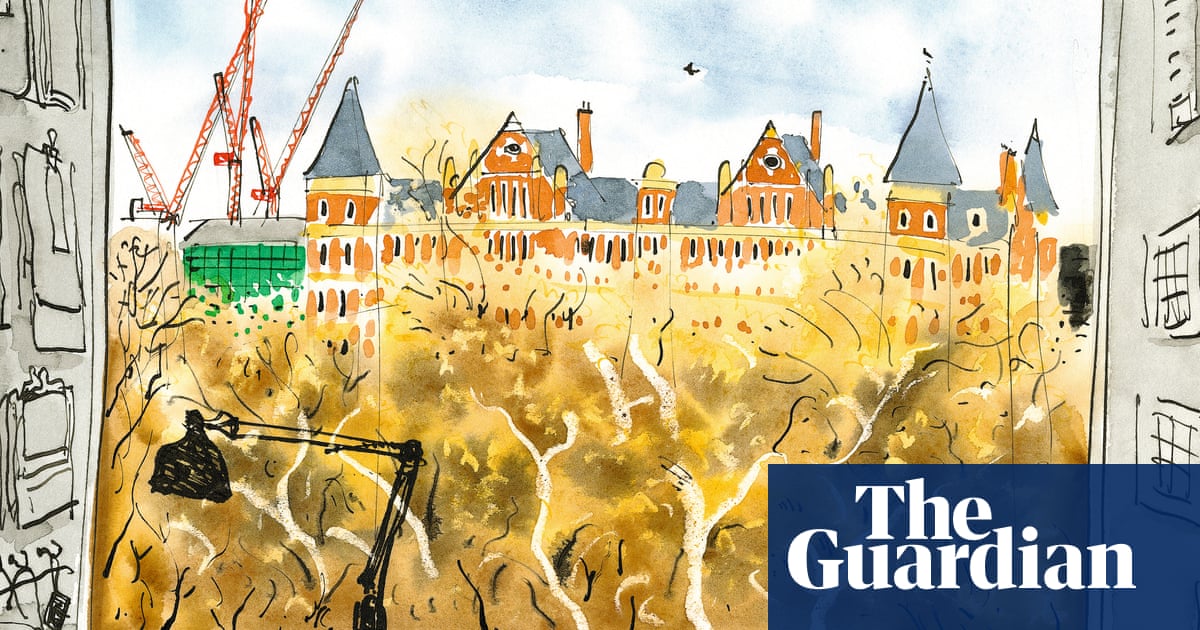You know the art of David Gentleman even if you don’t know you know it. Anyone who’s passed through London’s Charing Cross tube station has seen his life-filled black-and-white mural of medieval people, enlarged from his woodcuts, digging, hammering, chiselling to construct the Eleanor Cross that once stood nearby. His graphic art has graced everything from stamps to book covers toStop the Warposters in a career spanning seven decades. He says he’s been making art for 90 years, since he was five.
His parents were also artists, and in his latest book he reproduces a Shell poster by his father to show he follows in a modern British tradition of well-drawn, well-observed popular art. Perhaps it is because he learned from his parents as naturally as learning to speak – “Seeing them drawing tempted me to draw” – that Gentleman dislikes pedagogy. He’s proud that he never had to teach for a living, always selling his art. So his guide to the creative life, Lessons for Young Artists, is anything but a how-to manual or didactic textbook.
Instead, it’s like a visit to his studio where you sit at his shoulder, watching him work, while he shares tips, wisdom, anecdotes. If you have ever wished to take up pencil and paper, whatever your age, this book will sharpen your ambition by demystifying the process, making it feel the most natural and important thing in the world to draw that tree outside the window.
The book’s beautiful illustrations deepen his laconic advice. As he chats, the artist rifles through drawers to show views of London, Paris, New York. “Rifling” is possibly the wrong word, for it suggests a chaotic workplace, of which Gentleman does not approve. You should keep your brushes in good nick and your studio tidy. Then again there are no rules, he admits, remembering how Edward Ardizzone used to work at the kitchen table surrounded by his family.
The artist’s workspace may seem a secondary issue but he’s not alone in stressing it: Leonardo da Vinci paid attention to what an artist’s room should be like in advice to young hopefuls written more than 500 years ago. In one of Gentleman’s engrossing, calming drawings, his studio has a big window looking out on the city, designs on clipboards neatly hung up, a row of brushes, a couple of glasses of water (for watercolours). It’s a workplace to envy, peaceful yet connected with the world. This is really a guide not just to the technical skills an artist needs but achieving an artistic state of mind.
Gentleman lures you into his day-to-day work. “Take a sketchbook with you everywhere you go,” he says, again like Leonardo, adding that it should be pocket-sized and the accompanying tools minimal. Too heavy a kit will “become an excuse not to take it with you”.
He adds watercolour to his drawings, either in the studio or in the open. A Suffolk church is seen through overgrown late summer weeds, with watery blotches in the sky. It started to rain as he worked: “I like the way the spatters of rain are visible on the paper.” Another happy accident is a drawing of his son playing the piano that acquired an extra foot: a burst of motion in an otherwise tranquil scene.
You find yourself not just wanting to be an artist but to be David Gentleman. “Becoming an artist,” he says, “is about learning to look at the world with a very sharp eye. When you walk down the street, try to pause and notice your surroundings.” On the facing page is a watercolour shot through with sunlight of the now-gone King’s Cross gasometers, by a trashy canalside, ducks floating on the silver-touched water. Finding beauty in the neglected, unnoticed moments that pass us by is a lesson that can be applied to anyone’s life, “Young Artist” or not. This is diamond advice, lightly given.
Sign up toInside Saturday
The only way to get a look behind the scenes of the Saturday magazine. Sign up to get the inside story from our top writers as well as all the must-read articles and columns, delivered to your inbox every weekend.
after newsletter promotion
Lessons for Young Artists by David Gentleman is published by Particular (£20). To support the Guardian, order your copy atguardianbookshop.com
